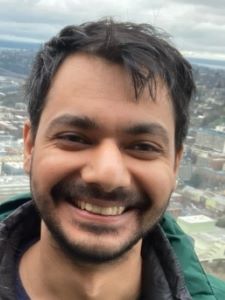Gaurav Chaudhary

Dr Gaurav Chaudhary
Research Fellow at Clare Hall College
Fellow of Clare Hall
Postdoc in Prof Slager's group
Office: 544 Mott Bld
Email: gc674 @ cam.ac.uk
ORCID: 0000-0002-1275-3400
TCM Group, Cavendish Laboratory
19 JJ Thomson Avenue,
Cambridge, CB3 0HE UK.
Research
I am generally interested in systems where the interplay between band topology and electron-electron correlations can lead to exotic emergent quantum phenomena. An excellent example of such phenomena is topological superconductivity, which has rich fundamental physics as well as great applications for future quantum technology because of the robustness it inherits from topology. One of the many proposed scenarios in which superconductivity can become topological is when pairing electrons come from topological bands, such as Landau levels. As an example, I have shown that in this setting, the topological classification of the superconductor is dictated by how the vortices in the superconducting order are arranged. Regarding physical systems, my recent focus has been on new moiré materials. These engineered materials are characterized by the long length-scale “moiré modulation” produced by a small mismatch between two layers of material. These highly tunable materials can be considered solid-state platforms for synthetic quantum matter. Therefore, the moiré modulation makes these new materials an exciting playground for topology, correlations, and fermionic quantum simulations, opening up many possibilities for novel quantum phenomena. A complete list of my publications can be found on ORCID and Google Scholar. I try to keep a broad approach to research topics. However, some that I am proactively working on these days are:
(i) Numerically exact studies of superconductivity in topological flat bands.
(ii) Polarization, ferroelectricity, and their relations to superconductivity in two dimensions.
(iii) Composite fermion construction without magnetic field (in moiré Chern insulators).
In Plain English
In some ways, quantum condensed matter physics can be considered social sciences of electrons. Just as social sciences are studies of people and their societies as emergent collective behavior; the result of their interaction with each other and the environment, quantum condensed matter physics is the study of emergent phenomena when the countless electrons in a material interact with each other and their environment (temperature, electric and magnetic fields, atomic nuclei, the “topological environment”). Unlike social sciences, however, we know exactly what fundamental laws of nature the electrons follow when undergoing these social interactions. Simply put, it is simply quantum mechanics + electrodynamics. The main difficulty lies in solving these governing laws for an exponentially complex system and predicting new collective behavior.
Understanding these collective behaviors is crucial to answering questions like why magnets attract each other or how electricity can flow without any energy loss in some materials known as superconductors. Beyond answering these fundamental questions about nature, understanding the quantum mechanics of many electrons in solids has also led to the development of technologies such as silicon chips, magnetic memory, and MRI machines.
Indeed, the quantum mechanics of many interacting electrons in solids is extremely rich and often leads to phenomena that defy all our intuitions. For example, when electrons in topologically special environments interact, they can sometimes behave as if they are their own anti-particles or if they are only a fraction of an electron. If you are shocked to hear that, you are not alone. I was too! Most of my research to date is my efforts in overcoming this shock. Moreover, new technologies are emerging based on these shocking phenomena for a new quantum revolution, of which we have barely seen the beginning.
Clearly, if we can somehow control the environment and interactions of electrons, we can tune and find new quantum phenomena. Such control is “effectively” possible in newly discovered moiré materials, where a slight mismatch between two layers of material creates a “moiré modulation.” This modulation is similar to the musical beats produced by mixing sounds from different instruments. A key theme of my current research is exploiting the moiré modulation and performing calculations to predict new quantum phenomena in moiré materials.
Featured Publications
Superconductivity from Domain Wall Fluctuations in Sliding Ferroelectrics. Gaurav Chaudhary and Ivar Martin, Phys. Rev. Lett. 133 , 246001 (2024)
Dualities of Paired Quantum Hall Bilayer States at $ \nu_T = 1/2 + 1/2 $. Luca Ruegg, Gaurav Chaudhary, Robert-Jan Slager, Phys. Rev. Lett. 133 , 156502 (2024)
Polar meron-antimeron networks in twisted bilayers. Daniel Bennett, Gaurav Chaudhary, Robert-Jan Slager, Eric Bousquet, Philippe Ghosez, Nat. Commun. 14 , 1629 (2023)
Twisted bilayers of thin film magnetic topological insulators. Gaurav Chaudhary, Anton A. Burkov, and Olle G. Heinonen, Phys. Rev. Res. 4 , 043034 (2022)
Quantum Hall superconductivity from moiré Landau levels. Gaurav Chaudhary, Allan H. MacDonald, and Michael R. Norman Phys. Rev. Res. 3 , 033260 (2021)
Multiple Flat Bands and Topological Hofstadter Butterfly in Twisted Bilayer Graphene Close to the Second Magic Angle. X. Lu, B. Lian, G. Chaudhary et. al., PNAS 118 (30) , e2100006118 (2021)
Vortex Lattice Structure and Topological Superconductivity in the Quantum Hall Regime. Gaurav Chaudhary and Allan H. MacDonald, Phys. Rev. B 101 , 024516 (2020)